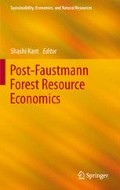Abstract
Timber supply is a primary object of economic modeling in forestry, especially in the context of policy evaluation. Policy changes have two potential effects on timber supply. First, they may change the relationship between the quantity of timber harvested and its determinants. Secondly, they may alter the values of the factors that influence timber supply. A standard approach for policy evaluation is to estimate the supply function from observed harvest behavior, and then use the obtained supply function to simulate the effects of policy changes. A limitation of this approach, known as the Lucas Critique in economics literature, is that it usually cannot capture the first effect of policy changes on timber supply. This paper presents a new approach to estimate the timber supply function by introducing two applications in counterfactual comparisons. The approach seeks to optimize the supply function parameters under a given set of policy conditions. In the first application, we determine the change in the supply function following a change of the market regime and measure the welfare gain from competition in the timber market. The second application examines the effects of tree improvements on the timber supply function and on the producer and consumer surplus. These two cases illustrate that our approach is capable of determining the change in the supply function coefficients induced by policy or technological changes. Results from the second application also show that ignoring the change in supply functions leads to significant underestimate of the welfare effects of biotechnological improvements in forestry.
Access this chapter
Tax calculation will be finalised at checkout
Purchases are for personal use only
Notes
- 1.
The statistical estimation of timber supply functions has been criticized by, among others, Binkley (1987). He claimed that the theoretical basis of the empirical models was week, and that the empirical data were poor. More importantly, for the present chapter, he pointed out that existing empirical timber supply functions describes the actual harvesting behavior within a given time period, and is conditioned on the ruling institutional setting. In other words, they have limited ability to evaluate policy and institutional changes. Binkley’s view is close to the more general Lucas critique.
- 2.
From the perspective of each forest owner, regeneration using the IRM will result in a greater yield of timber, but will not affect the timber price when timber market is competitive. Thus, each forest owner can increase his/her profits (or reduce the loss) by changing to the IRM after an existing stand is harvested, irrespective the decisions of the other forest owners.
References
Bentzel R, Wold H (1946) On statistical demand analysis from the viewpoint of simultaneous equations. Skandinavisk Aktuarietidskrift 95–114
Binkley CS (1987) Economic models of timber supply. In: Kallio M, Dykstra DP, Binkley CS (eds) The global forest sector: an analytical perspective. Wiley, New York, pp 109–136
Buongiorno J et al (2003) The global forest products model. Academic, London
Burtless G, Hausman JA (1978) The effect of taxation on labor supply: evaluating the Gary negative income taxation experiment. J Polit Econ 6:1103–1130
Dasgupta P, Heal G (1979) Economic theory and exhaustible resources. Nisbet, Cambridge
Estrella A, Fuhrer JC (1999) Are “deep” parameters stable? the lucas critique as an empirical hypothesis. Federal Reserve Bank of Boston, Working Paper 99–94, Sept
Friedman M (1968) The role of monetary policy. Am Econ Rev 58:1–17
Gong P (1994) Adaptive optimization for forest-level timber harvest decision analysis. J Environ Manage 40:65–90
Gong P (1995) An optimization approach to identifying timber supply function coefficients. Nat Resour Model 9:25–50
Gong P, Löfgren KG (2003) Timber supply under demand uncertainty: welfare gains from perfect competition with rational expectations. Nat Resour Model 16:69–97
Gong P, Löfgren KG (2009) Modeling forest harvest decisions: advances and challenges. Int Rev Environ Resour Econ 3:195–216
Gong P, Löfgren KG, Rosvall O (2012) Economic evaluation of biotechnological progress: the effect of changing management behavior. Nature Resource Modeling (in print)
Haavemo T (1943) The statistical implications of a system of simultaneous equations. Econometrica 11:1–12
Hultkrantz L, Aronsson T (1989) Factors affecting the supply and demand of timber from private nonindustrial lands in Sweden: an econometric study. For Sci 35:946–961
Linde J (2001) Testing the Lucas critique: a quantitative investigation. Am Econ Rev 91:986–1005
Lucas RE (1976) Econometric policy evaluations: a critique. In: Brunner K, Meltzer AH (eds) Carnegie-mellon conference on public policy 1. Amsterdam
Phelps ES (1967) Phillips curves, expectations of inflation and optimal unemployment over time. Economica 34:254–281
Phillips AW (1958) The relation between unemployment and the rate of change of money wage rates in the United Kingdom 1861–1957. Economica 25:283–289
Prescott E (1986) Theory ahead of the business cycle measurement. Fed Reserve Bank Minneap Q Rev 10:9–22
Ruist E, Svennilsson I (1948) Den Norrländska Industriens Konjunkturkänlighet under Mellankrigsperioden. Industriens Utredningsinstitut, Stockholm
Sims C (1980) Macroeconomics and reality. Econometrica 48:1–48
Tinbergen J (1937) An econometric approach to business cycle problems. Actual Sci Industr 525
Acknowledgments
The authors acknowledge the financial support from a research grant from the Swedish Environmental Protection Agency. Comments from Shashi Kant at University of Toronto significantly improved the quality of the paper.
Author information
Authors and Affiliations
Corresponding author
Editor information
Editors and Affiliations
Rights and permissions
Copyright information
© 2013 Springer Science+Business Media Dordrecht
About this chapter
Cite this chapter
Löfgren, KG., Gong, P. (2013). Economic Modeling in Forestry: Avoiding the Lucas Critique. In: Kant, S. (eds) Post-Faustmann Forest Resource Economics. Sustainability, Economics, and Natural Resources, vol 4. Springer, Dordrecht. https://doi.org/10.1007/978-94-007-5778-3_11
Download citation
DOI: https://doi.org/10.1007/978-94-007-5778-3_11
Published:
Publisher Name: Springer, Dordrecht
Print ISBN: 978-94-007-5777-6
Online ISBN: 978-94-007-5778-3
eBook Packages: Business and EconomicsEconomics and Finance (R0)

